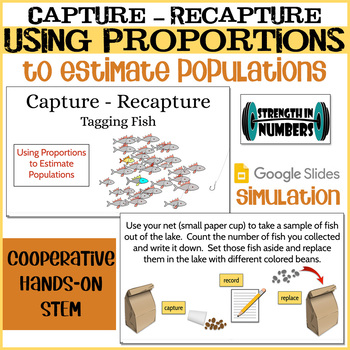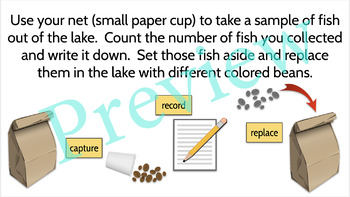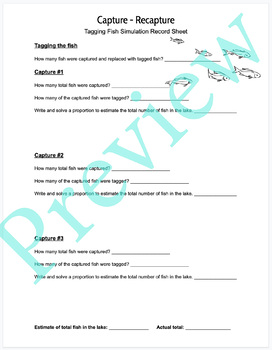Using Proportions to Estimate Fish Populations Simulation: Capture - Recapture
Strength in Numbers
942 Followers
Grade Levels
6th - 9th
Subjects
Resource Type
Standards
CCSS7.SP.A.2
CCSS7.RP.A.2
CCSS7.RP.A.2c
Formats Included
- PDF
- Google Apps™
Pages
10 pages
Strength in Numbers
942 Followers

Includes Google Apps™
The Teacher-Author indicated this resource includes assets from Google Workspace (e.g. docs, slides, etc.).
Description
Show your students how proportional thinking is used by scientists to estimate wildlife populations using a capture - recapture process. In cooperative groups, students will use a lake (paper bag) full of fish (beans) to capture, tag, recapture, and record their findings. They will use their data to write proportions and estimate the total number of fish in the lake. Students will use easy-to-follow instructions on an editable Google Slides presentation and record their data and work on an included paper. Supplies needed (per group) include: paper bags, dry beans (or other item to represent fish), and small paper cups - all found at most dollar stores.
Total Pages
10 pages
Answer Key
N/A
Teaching Duration
50 minutes
Report this resource to TPT
Reported resources will be reviewed by our team. Report this resource to let us know if this resource violates TPT’s content guidelines.
Standards
to see state-specific standards (only available in the US).
CCSS7.SP.A.2
Use data from a random sample to draw inferences about a population with an unknown characteristic of interest. Generate multiple samples (or simulated samples) of the same size to gauge the variation in estimates or predictions. For example, estimate the mean word length in a book by randomly sampling words from the book; predict the winner of a school election based on randomly sampled survey data. Gauge how far off the estimate or prediction might be.
CCSS7.RP.A.2
Recognize and represent proportional relationships between quantities.
CCSS7.RP.A.2c
Represent proportional relationships by equations. For example, if total cost 𝘵 is proportional to the number 𝘯 of items purchased at a constant price 𝘱, the relationship between the total cost and the number of items can be expressed as 𝘵 = 𝘱𝘯.




